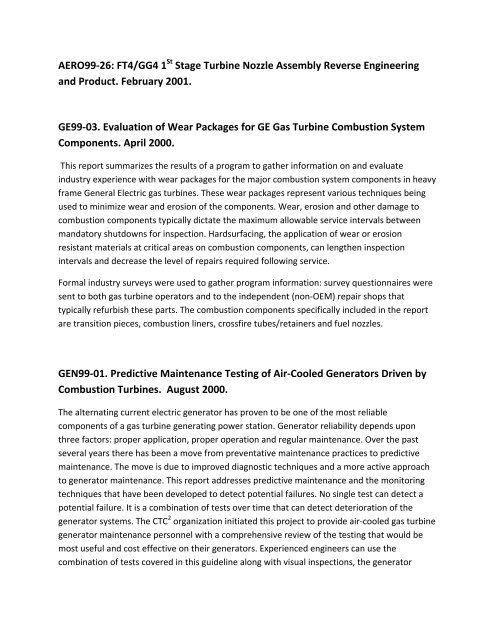GE94-02: Repair Flow Testing and Calibration Procedures for ...
GE94-02: Repair Flow Testing and Calibration Procedures for ...
GE94-02: Repair Flow Testing and Calibration Procedures for ...
You also want an ePaper? Increase the reach of your titles
YUMPU automatically turns print PDFs into web optimized ePapers that Google loves.
AERO99‐26: FT4/GG4 1 St Stage Turbine Nozzle Assembly Reverse Engineering<br />
<strong>and</strong> Product. February 2001.<br />
GE99‐03. Evaluation of Wear Packages <strong>for</strong> GE Gas Turbine Combustion System<br />
Components. April 2000.<br />
This report summarizes the results of a program to gather in<strong>for</strong>mation on <strong>and</strong> evaluate<br />
industry experience with wear packages <strong>for</strong> the major combustion system components in heavy<br />
frame General Electric gas turbines. These wear packages represent various techniques being<br />
used to minimize wear <strong>and</strong> erosion of the components. Wear, erosion <strong>and</strong> other damage to<br />
combustion components typically dictate the maximum allowable service intervals between<br />
m<strong>and</strong>atory shutdowns <strong>for</strong> inspection. Hardsurfacing, the application of wear or erosion<br />
resistant materials at critical areas on combustion components, can lengthen inspection<br />
intervals <strong>and</strong> decrease the level of repairs required following service.<br />
Formal industry surveys were used to gather program in<strong>for</strong>mation: survey questionnaires were<br />
sent to both gas turbine operators <strong>and</strong> to the independent (non‐OEM) repair shops that<br />
typically refurbish these parts. The combustion components specifically included in the report<br />
are transition pieces, combustion liners, crossfire tubes/retainers <strong>and</strong> fuel nozzles.<br />
GEN99‐01. Predictive Maintenance <strong>Testing</strong> of Air‐Cooled Generators Driven by<br />
Combustion Turbines. August 2000.<br />
The alternating current electric generator has proven to be one of the most reliable<br />
components of a gas turbine generating power station. Generator reliability depends upon<br />
three factors: proper application, proper operation <strong>and</strong> regular maintenance. Over the past<br />
several years there has been a move from preventative maintenance practices to predictive<br />
maintenance. The move is due to improved diagnostic techniques <strong>and</strong> a more active approach<br />
to generator maintenance. This report addresses predictive maintenance <strong>and</strong> the monitoring<br />
techniques that have been developed to detect potential failures. No single test can detect a<br />
potential failure. It is a combination of tests over time that can detect deterioration of the<br />
generator systems. The CTC 2 organization initiated this project to provide air‐cooled gas turbine<br />
generator maintenance personnel with a comprehensive review of the testing that would be<br />
most useful <strong>and</strong> cost effective on their generators. Experienced engineers can use the<br />
combination of tests covered in this guideline along with visual inspections, the generator


